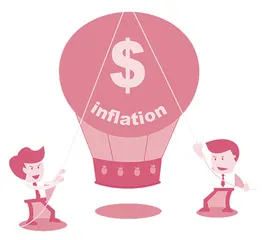How Companies Can Prepare for High Inflation企业如何应对高通胀
作者: 维贾伊·戈文达拉扬等 薛洪君/译

While consumers generally dislike inflation because it erodes the purchasing power of their income, businesses desire a steady level of inflation because investments made in today’s prices yield higher profits and returns in the future. Governments also like low and steady inflation. With inflation, government’s long-term borrowing needs to be repaid at a lower real cost, and a nation’s real income keeps increasing as long as employment remains high and the improvement in worker productivity exceeds their wage enhancements. Prices of assets such as houses and equities1 keep rising, attracting investors into the economy. The idea is that the economy keeps growing and everyone benefits.
消费者通常都不喜欢通货膨胀,因为它让你收入的购买力缩水;而企业会希求持续通胀,原因是以今天的价格做投资,未来能产生更高的利润和收益。政府也乐见小幅平稳的通货膨胀,此种现象下,政府的长期借债只需以更低的实际成本偿还,同时只要保持高就业率且工人生产能力的提高超过工资增长,国家的实际收入就会持续增加。房产和股票等资产的价格保持上涨,吸引投资者参与经济活动。道理就是经济不断增长,人人都从中获益。
Why inflation is so high right now
为何当前通胀如此之高
Despite demand for goods and services reaching or even exceeding pre-pandemic levels, supply hasn’t caught up. Covid-related supply chain issues persist, with many goods remaining stuck in ships or ports. Shipping, freight, and insurance rates have skyrocketed2 to multiple times their pre-pandemic levels. Many factories remain closed or have not resumed operations. Wages keep rising, and companies are still struggling to hire enough talent. A widespread shortage of truck drivers is affecting production chains.
尽管对货品和服务的需求已达到甚或超过疫情前的水平,供给却没有同步赶上。新冠肺炎相关供应链上的问题依旧存在,众多货物积滞在船上或港口。航运、货运和保险费用蹿升为疫情前多倍水平。很多工厂依然停业或尚未恢复运营。工资持续上涨,企业仍难以招募到足够的人才。到处缺少货车司机,使得生产链受阻。
The risks of protectionism
贸易保护主义的风险
One likely outcome of these developments is that countries could turn protectionist, reversing decades of trade and specialization progress. For example, over the last 40 years or so, manufacturing moved away from the U.S. significantly. Meanwhile, California’s Silicon Valley became the global leader in new digital businesses ideas, and China’s Shenzhen region created an ecosystem for manufacturing electronic products. In addition, Brazil became the largest exporter of beef, China of steel, Canada of aluminium, Germany of cars, and the U.S. of radios and TVs and refined petroleum.
上述发展的一个可能的后果是,各国会走向贸易保护主义,使数十年间在贸易和生产专业化上取得的进步发生逆转。例如,过去大约40年中,制造业大举迁出美国。在此期间,加利福尼亚硅谷成为全球新数字化商业理念的领导者,中国深圳地区则建成了电子产品制造生态系统。此外,巴西的牛肉出口成为世界之最,中国的钢铁、加拿大的铝、德国的汽车以及美国的无线电、电视和精炼石油等也都如此。
In other words, each region started specializing in producing goods in which it had comparative advantage or economies of scale. Goods crisscrossed3 the globe at various production stages before reaching customers. This specialization and trade lowered prices of goods and services and accelerated innovation. Just consider the price you recently paid for a large-screen LCD TV. You might find it to be lower than the inflation-adjusted price you paid for a small black-and-white TV in the 1990s. This was the outcome of well-functioning specialization and global trade. Countries are better off4 specializing in a few things and trading the rest, instead of trying to be self-sufficient.
换句话说,每个地区都开始专精生产自己具备相对优势或规模效应的商品。商品交叉往来于全球各地,经历各个不同的生产阶段,再交付到消费者手中。这种专业化生产与贸易降低了商品和服务的价格,使创新加速。只需想想新买的大液晶屏电视机的价格,你或许就会发现,它要比在1990年代买一台小黑白电视通胀调整后的价格还低。这就是专精生产和全球贸易良性运行的效果。各国专精生产几项产品,其余的经由通商贸易获得,而不勉强去追求自给自足,各国境况反而更好。
Now there is a real danger that at least some of that progress could be lost or reversed, forever. Countries may revert to more protectionist policies and attempt to become more self-reliant. Imagine a scenario where each country attempts to have its own steel mills, produces its own cars, runs its own airlines, and has its own oilfields and refineries5. This would make goods and services more expensive.
而今切实存在的危险就是,至少上述某些进步会丧失或倒退,不复再现。各国可能会重返更严重的贸易保护主义政策,尝试更加自力更生。想象一下:各国都试图建立自家的钢铁厂,生产自己的汽车,运营本国航空线,自搞油田和炼油厂。这会让商品和服务更昂贵。
What companies should do about inflation
企业针对通胀应如何行动
We don’t think inflation will be coming down anytime soon. Here are seven new strategies for companies to combat longer-lasting inflation:
我们认为通货膨胀不会在短时间内减缓。以下是企业可用以对付更长期通胀的七条新策略:
First and foremost, understand your entire value chain and its exposure to supply chain shocks. In other words, go beyond learning about just your immediate supplier—figure out the supplier behind your supplier, and so on. Even a minor subcomponent crisscrosses the world at various manufacturing stages. Assess the risk of disruption at each stage, develop alternative sources of supply, and keep sufficient inventory. Those days of keeping lean, just-in-time inventories are gone.
首要的一点是,悉知你整个价值链条及其中易受供应链危机冲击的环节。也就是说,除了解你的直接供应商外——还要搞清你供应商背后的供应商,诸如此类。即使是一个不起眼的子部件,也会交叉往返于全球,经历各个不同的制造阶段。评估每一阶段的供应中断风险,研究可替代货源,并保持库存充足。保持精简的准时制库存的时代已经过去了。
Understand your capital structure: your mix of equity shares, preferred shares, bank loans, short-term credit, supplier credit, and convertible debt. See which ones need to be repaid and when, which are affected by interest rate increases, and which could bring your business down if you default. Financial plans that worked during the last decade may be too risky for the coming years. Restructure your loans, obtain new lines of credit6, and maintain enough cushion.
弄清你的资本结构:即权益股、优先股、银行贷款、短期信贷、供方信贷和可转换债券的成分比例。注意有哪些需要偿还和何时偿还,哪些受利率升高的影响,还有哪种一旦违约会把你的生意搞垮。过去十年行之有效的金融计划,如果未来几年继续沿用,可能风险过高。调整贷款结构,获取新的信贷额度,保有足够的储备金。
Pay extra attention to global developments, realignment of countries’ alliances, and changing policies of international suppliers. These factors can no longer be taken for granted. You can’t expect that countries will act rationally in their long-term economic interests. Politics, international pressures, and national fervor could dominate rational economic thinking, leading to rapid changes in business policies.